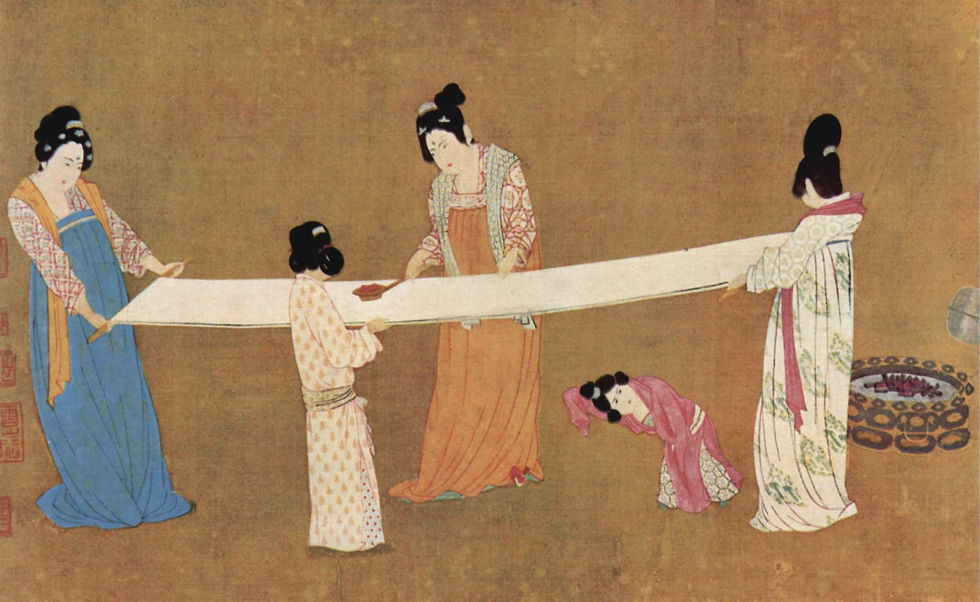
Tutankamun's Death Mask - the Blue Stripes are a Lapis Lazuli Imitation Paste
In my Augustus blog a few days ago, I talked about Egypt and Roman trading with India. Combined, both generated 70 – 80% of Rome’s total tax income. East-West trading was very profitable for millennia. After the fall of Rome (476 AD), it dropped to a trickle but during the crusades it was resumed. Venice, Genoa, Noli (we visited them all) and Amalfi (on the list for 2026) made a fortune from participating in it. The Ottoman – Mamluk War in 1517 was fought for control over it. In the 18th and 19th century, profits from trading with India and China financed the industrial revolution in England.

Chinese Women checking Silk during the Sung Dynasty (10th - 13th Century)
Am trying to understand the trade in terms of supply and demand. The price of pepper increased from India to Lisbon (the only numbers I have) by the factor 100. Pepper in India is as abundant as wines in Europe. Botanically, it is part of the family of grapes. Wonder how people in the west found out that they liked pepper and how they could afford to pay such a high price. The long chain of intermediaries must have been the reason for the big price increase. In India, pepper had to be brought to a port. Then shipped over the Indian Ocean and up the Red Sea. Transported overland to Alexandria. Then loaded on ships to Rome. Only non-perishable goods could make this months-long journey. They were taxed in every port and et every stop.

How did people discover pepper - to use one spice as an example? I did not know about focaccia bread until I visited Genoa. Did anyone travelled to India to find out? Probably not. I guess traders from India brought it with them when they sailed to western shores.

Camelian Beads from Ur (2'300 - 2'600 BC) now in the British Museum
Archeologic findings proof that trade relations between the Indus Valley civilisation and Mesopotamia existed by latest 2’500 BC. Seals with ships with direction finding birds were found in both places. There were also plenty of etched carnelian beads from India found in tombs in Ur, one of Mesopotamia’s largest and earliest cities. Making these beads required sophisticated techniques and craftsmanship which was developed in the Indus Valley many thousands years earlier. As we know from the 12’000-year-old site Boncuklu Tarla, people knew how to make copper beads already. In the Indus Valley, carnelian and Lapis Lazuli breads were found from 8'000 BC. Beads were used for personal use and as gifts to Gods.

Possible Trade Routes between Egypt and Mesopotamia. Egyptian Pharaohs sailed to the Land of Punt (modern Yemen) by 1'950 BC. The sea route is thus entirely possible
Given the discoveries in Turkey and India, a case can be made that trade links between Indus Valley and Mesopotamia are much older than 4'500 years. The two regions were closer before sea levels rose at the end of the ice age in 8’000 BC. Several inundated towns were already discovered on the sea floor. Once underwater archaeology in those depths is technically feasible, we probably learn much more about the trade. One indication that the East-West trade is very old are the findings of Lapis Lazuli in Egypt. Lapis Jewellery in the form of amulets and scarabs were found at a pre-dynastic site of Ombos (modern Naqada).

Bone Figure from near Luxor from
prob. 3'500 BC with Lapis Lazuli Eyes
How did Lapis Lazuli get from north-eastern Afghanistan to Egypt by 3’500 BC? Certainly via Mesopotamia. Egypt became a large importer of Lapis Lazuli around the 3rd millennia BC. The blue Lapis Lazuli stone (stone of the sky) represented the colour of the heavens for Egyptians and was used – together with gold as symbol for the sun – for the Pharaohs’ death mask. Tutankamun’s mask is - to my knowledge - the only which was never discovered by grave robbers. The people who shipped Lapis Lazuli from the mouth of the Indus River to Egypt must have brought pepper along – to prepare their daily meals. I guess Egyptians tried and liked the spice.

Lapis Lazuli Statue from Naqada
Lapis Lazuli is a decorative semi-precious stone. It has no other value. It must have been expensive to acquire. It was only found in royal tombs and graves of high-ranking officials. This gets me to the demand side. Without wealthy customers who can pay for such luxuries, there is no trade. The goods would stay in India. The East-West trade is thus a sign of wealth and increased as societies in the Middle East got wealthier. With three harvests per year, Egypt was the richest country in antiquity and stayed so to early modern times. Even under the Ottoman Empire, Egypt accounted for half of Turkish taxes. The Pharaohs paid with gold for imports from India. A few millennia later, the equally wealthy Roman Empire paid with silver. In modern times, Portugal and Spain paid with silver from Bolivia.

Sumerian Necklace with Gold and Lapis Lazuli Beads
from 2'600 BC - Metropolitan Museum in New York
Today, when looking at Lapis Lazuli pendants in the window of a jewellery shop or standing in front of a spice shelf in a supermarket, we hardly think of a 10’000-year-old trade that led to the discovery of the world and made many participants rich. It also financed the development of our modern technology which we take so for granted.
What do Augustus and Tutankhamen have in common? They both heavily taxed the East-West trade and financed more than 1/3 of state expenditure with the proceeds.
Comments